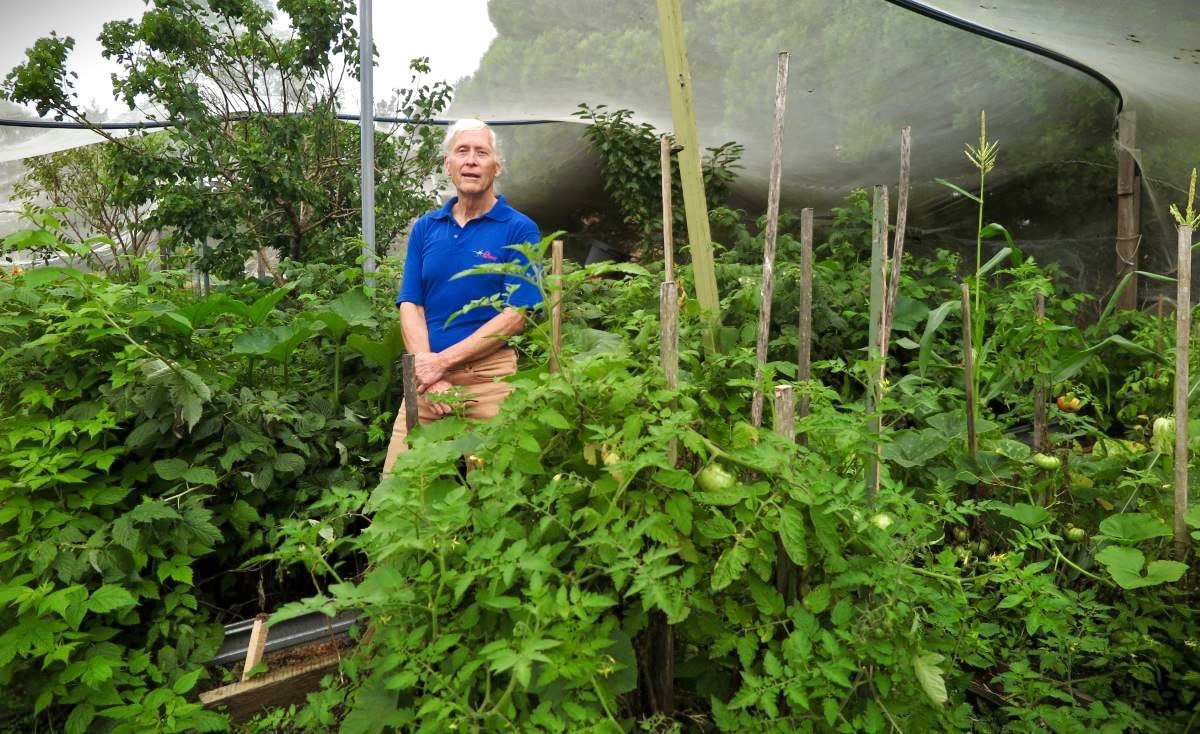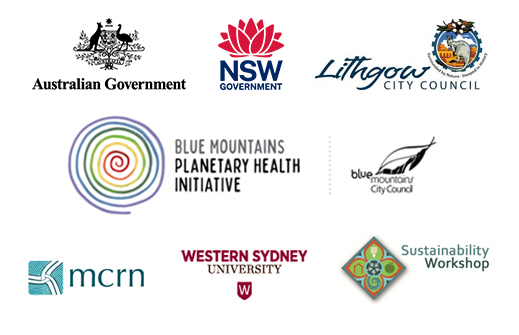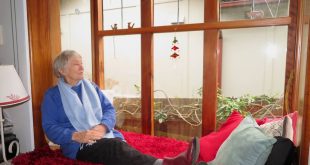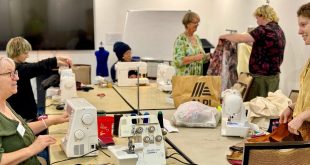
Chris McDonald, within his handmade Eden of raspberry, fruit trees, tomatoes and other veg, says it’s possible to protect our crops without killing things.
Story and photos by Linda Moon
Do you baulk at killing garden pests? Chris McDonald, Principal Gardener at the Brahma Kumaris Retreat Centre, Leura, shares tips for keeping the pests at bay without killing anything, harming the environment or ourselves.
Key Points:
- Battling pests is one of the most challenging aspects of growing food for backyard gardeners and farmers.
- Up to 40 per cent of global crop production is lost to plant pests and pathogens, according to a UN report. Climate change and global warming are worsening the problem by promoting conditions ideal for insect pests.
- As part of their green living spiritual journey, the Brahma Kumaris use methods for garden pest control that touch more lightly on the planet.
The Brahma Kumaris view all life as sacred and violence as bad karma. It’s this belief that has led the spiritual organisation to invest time, thought and money into ways to grow food without harm to the environment or the critters within it.
Chris McDonald, principal gardener at the Brahma Kumaris Retreat Centre at Leura, is averse to killing pests. “All living things, no matter what they are, have a right to live,” the gentle gardener says. “There’s no life on Mars. If you look at that contrast, even a tiny insect is really special – even if it might be a pest. It’s a living thing.”
This view that all life is sacred is shared by a lot of First Nation cultures, he says. “Even things you look at as pests.”
Others of us are simply too time poor or too squeamish about killing to attack the problem of garden pests. What can we do?

Here, there and everywhere. Garden pests are a problem all over the world. A physical barrier is your best tactic against hungry wildlife, Chris says.
Large-scale barrier methods
“The best deterrent is a fool-proof structure,” Chris says. “Food is a very motivational thing for animals.”
At the Leura Retreat Centre, Chris and his helper, Russ, built a 15 metre wide, 50 metre long netted enclosure to protect the permaculture garden. The project – created using bird netting and flexible irrigation pipe – took them four months worth of weekends.
Build the frame first, Chris advises (make sure it’s strong enough to support what you put on it), then the side fencing. Add the netting and tie down. To keep out burrowing animals – like rabbits, mice and rats – he recommends building your enclosure well down below the ground like a fox-proof structure.
In considering the height of your structure think about what kind of trees and plants you want to grow. “If you want fruit trees you can obviously cut those back to a certain height,” he says. “But you still need a reasonable height.”
There are many materials that can be used for your structure. These include wood or steel frames. The bird netting has been fantastic for excluding birds, Chris says. “In natural areas like this in the bush we have a lot of native birds and parrots. If we let those in here we probably would have nothing left.” He says mesh lasts longer than bird netting, but costs more.
Think about the degradation of your system over time, and how you’ll manage that. “Is it going to be made of really strong, long-lasting materials or are you going to replace those in time?” he says. “Everything degrades. It’s a natural process.”
“Anyone can make a structure like this, depending on your backyard and where you are.” – Chris McDonald.
NB. WIRES stresses that the wrong type of netting can be deadly. Hungry animals are easily caught in ‘bird netting’, which has a mesh size greater than 1cm square. Wildlife friendly netting should have a mesh size of less than 5 mm. For more information visit their page on Wildlife Friendly Netting

Large-scale netting protecting a fig tree.
Small barrier methods
Where an enclosure isn’t possible, because of money, space or other factors, “you’ve just got to manage the pests as best you can,” Chris says.
Smaller barrier methods on individual plants or garden beds can work. Useful materials and products include netting, fine mesh, row covers, polytunnels, collars, cloches, fencing, snail and slug barriers, small greenhouses, cut off plastic bottles and other do-it-yourself ideas.
Chris has installed wire cages around his cucumbers, zucchinis and pumpkins. These work a treat against small mammals.

Nifty idea. Wire cages protecting the cucumbers against hungry wildlife like mice and possums – are highly effective, Chris says.
Biodiversity, not pesticides
Rather than the mentality of wiping out the pests, Chris, who has an aquaculture degree and has previously worked with plants within the zoo industry, advocates encouraging the natural balance of life to control pest species. Key to this strategy (based on permaculture) is cultivating biodiversity.
As well as many different types of food plants, fruit trees and berries, a range of species ramble through the Brahma Kumaris garden. The flourishing tomato crops consist of six varieties – Grosse Lisse, Tiny Toms, Italian tomatoes and others. Herbs, greens, turmeric, corn, rocket, tomatoes, pumpkin and beans also thrive in the sanctuary.
The benefits of biodiverse cropping are supported by mounting research. A study published in Nature found one key way variety in the garden works is by reducing nutrients to herbivorous insects. The study found variable nutrient traits across plant communities suppressed pest insect populations and performance. While variety might seem like abundance to humans, to insects who specialise on one crop it’s more like lean cuisine. Monocultures of one or few plant species, on the other hand, are like a feast to the insects that thrive on them.

A biodiverse landscape is a healthy one, Chris says. Lots of plant and species variety helps keep the pests at bay.
Grow organic
The garden flourishes without the use of pesticides or agri-chemicals. Growing organically is kinder to not only the bugs and the environment, but to us. A large body of research links pesticides to serious health issues in humans including cancer, hormone dysfunction, asthma and birth defects.
Pesticides are a well researched leading cause of species decline in bees, dragonflies, birds, frogs and other aquatic species. As many of these are key predators of garden pests, it’s believed the pest problem is related to their dearth and an out of balance ecosystem. A review of the extinction crisis in insects blamed pesticides and other pollutants as the second leading cause (after habitat loss through urbanisation and agriculture). In the long-term, pesticides and other agri-chemicals also erode soil health and contribute to Earth’s burden of pollution.
“We have to find natural ways the environment works with these things.” – Chris McDonald.

Tomatoes grown organically in the garden.
Attracting predators
One of the best ways to manage pests is to encourage their natural predators with shelter and food, Chris says. He rarely sees slugs or snails in the beds – something he attributes to visits from Blue Tongue Lizards and Skinks. “Here in the bush we’ve got a lot of predatory animals around too – owls and snakes,” he says.
The enclosure has gaps big enough to allow entry to reptiles, frogs and beneficial insects. “We don’t want to exclude the good things,” Chris says. “Anything that will let those in will let a little mouse in too. We do lose a little bit occasionally to the pests. That’s something you have to live with I suppose. It’s like nature: it’s a balance.”
Part of the balance includes flowers. Weaving through the intertwining crops are sweet-scented alyssum, purple violas, scarlet nasturtiums and other flowers. Along with being edible, and helping attract pollinators like bees, the flowers offer food for predatory insects – like hoverflies and wasps.
Proof of the strategy, a study published in Scientific Reports, found the availability and accessibility of flower nectar was a prime factor in successful biological control of crop insect pests by parasitic insects.
Avoid monocultures, Chris says. “A lot of the reptiles, insects and so forth, don’t like that; they won’t come in.” An assortment of leaf shapes and sizes and places for insects to hide offers an array of habitats for a range of beneficial species.
A study reported in The Guardian suggests we should not underestimate these garden helpers, no matter how tiny. It found some ant species are as effective as pesticides – or even better – when it comes to controlling pests. According to the researchers, ants perform best with crops grown in shady sites or with trees.

Gaps in the enclosure allow bees in (to fertilise this pumpkin) plus other creatures beneficial to the garden.
Trap and relocate
To combat mice and rats, Chris has an Elliot Trap in the garden. An inexpensive and humane option for rodent issues, it’s a small, metal box with a spring-operated door and weight sensitive base. When triggered by something entering the box, the door closes.
Chris uses a mix of peanut butter and oats (placed on the far end of the trap) to lure the mice in. “Rats and mice, whether they’re native or not, love peanut butter,” he says.
Over the past year, he’s caught about 15 mice and rats. The rodents are released elsewhere on the 50-hectare property, away from the temptations of the food garden.
The trap needs to be cleaned and maintained constantly, plus checked each morning to minimise harm or stress to any trapped creatures.

The Elliot Trap – a kinder option for mice and rats. But don’t forget to check it daily.
Sensory deterrents
Possums are another cause of damage to the permaculture garden. Chris points to a fruit tree whose upper branches have been stripped by the marsupials.
Unlike mice and rats, the native marsupials can’t be trapped and relocated. To try to deter them, Chris has trialed an Ultrasonic Device in the garden. The box-shaped object emits an intense piercing ultrasonic buzz supposed to scare off possums. Does it work?
“I’ve found it lasts for a few months and then the possums will go ‘yeah, I don’t like that but I’d rather have some food anyway’,” he admits. “They’ll come in and not worry about the noise eventually.” He says, some people have reported success with it.
Other deterrents on the market (for possums and other pests) include those that replicate the sounds, sights or scents of predators.

The Ultrasonic Device positioned in the garden. Deters humans as well!
Power plants
Keeping plants healthy and strong helps discourage pests and diseases. “Like a human being, if you’ve got a good immune system it’s a much more reliable system to fight any diseases you get,” he says. “It’s no different with plants.”
Focus on quality soil, natural fertiliser, good air ventilation and water, Chris says. When it comes to the latter, he finds natural rainwater produces more growth and vitality than that from the tap. “Because tap water has chlorine and fluoride and so forth,” he says. “Rain water is energised by the ions in the air.”
Airflow is especially important to think about in any closed off system. “A lot of the greenhouses that exclude animals very well, unfortunately, because they don’t have free flow of air, can get things like funguses and moulds,” he says.
To help enrich the soil the garden includes lots of comfrey. “Comfrey is an amazing plant because it produces nitrogen, phosphorus and potassium, which are the main ingredients for fertiliser,” Chris says. Along with making comfrey stews and adding the herb to compost, he breaks off leaves and scatters them next to other plants. “That breaks down and you get wonderful growth,” he says.
Also rotate your crops, Chris says. This helps reduce garden pests and diseases by disrupting their food supply and life cycle.
“You’ve got to look at the real world outside; how does it work, how does it function, and try and replicate that as best you can; but at the same time you’ve got to manage the pests and diseases that may get in occasionally.” – Chris McDonald.

These thriving oranges are among the healthy food plants growing in the permaculture garden.
Take Action:
- Create physical barriers against pests in your garden.
- Build a healthy, biodiverse ecosystem with a wide variety of plants.
- Avoid pesticides and encourage predator species.
Share this article:
This story has been produced as part of a Bioregional Collaboration for Planetary Health and is supported by the Disaster Risk Reduction Fund (DRRF). The DRRF is jointly funded by the Australian and New South Wales governments.

More from around the region
Did you know that old lino, window putty, and adhesive can contain asbestos? Yesterday the Asbestos & Hazardous Materials Management Conference kicked off with a pre-conference workshop at the Blue Mountains Planetary Health Centre. It included hands-on `spot the asbestos` and asbestos sampling sessions. This year`s theme is `Working together for a safe and healthy future`. #asbestos #hazardousmaterials #conference #planetaryhealth #bluemountains #katoomba
A huge thank you to Josh Logan from Logan Signs, Lithgow, for installing our Circular Water Signage in time for our World Animal Day Celebration today at the Blue Mountains Planetary Health Centre (33-39 Acacia St Katoomba). We have a full program of events with lots of information on how to prepare for the summer ahead and how to create urban areas that help us share our home respectfully with all species. It will be a fun family day too with storytime, craft and live music for kids! (Link in profile) #worldanimalday #planetaryhealth #familyday #katoomba #bluemountains
And our Wild Life exhibition is now up for World Animal Day tomorrow at the Blue Mountains Planetary Health Centre. Photographs by Warren Hinder, Merryl Watkins, Holly Kent and Tracy Burgess. Check out all the other events from stalls, talks, possum box demo, kid`s craft and animal storytime, plant based food and live music to Bushcare. @33-39 Acacia St Katoomba Link in profile. #planetaryhealth #worldanimalday #katoomba
Join the Blue Mountains Planetary Health Initiative at World Animal Day this Saturday 5 October for a discussion on the history of the Plant Based Food Movement in Australia and a discussion of exciting contemporary trends. It will be followed by a Plant Based Cheese Degustation to launch the Plant Inspired Community Cooking Project. This will be a series of cooking classes to introduce the community to plant based cooking techniques. The event is free but places are limited so bookings essential (link in profile): https://bit.ly/3Bzbwhu
#plantbasedcooking #worldanimalday #bluemountains #katoomba #planetaryhealth #communitycooking
We share the Blue Mountains with so many extraordinary beings but have you seen them and do you know their names? Do you know the difference between a Royal Spoonbill and an Eastern Shrike-tit, or the difference between a bandicoot and an antechinus? Come and check out our Wild Life Exhibition at World Animal Day this Saturday to learn more from the stunning photographs by Warren Hinder, Merryl Watkins, Holly Kent and Tracy Burgess. There will be also be a Breakfast with the Birds at 8.30am, Animal Storytime and Craft for kids from 10am, stalls, talks, food and live music. The day is free but please book via Eventbrite to help us cater (link in profile): https://bit.ly/4eMhbz0 @bluemountainswalks @merrylwatkinsphotography @bestofbluemountains
#royalspoonbill #easternshriketit #wildlife #birdsofthebluemountains #bluemountains #katoomba #worldanimalday #biodiversity #planetaryhealth
To coincide with the first day of Bushfire Season we launched Air Watch at the Planetary Health Centre yesterday. For the last seven years Blue Mountains Unions & Community have been working tirelessly to ensure residents of the Blue Mountains and Lithgow are able to measure and track the quality of the air we breathe. The Blue Mountains Planetary Health Initiative has worked closely with them over the last year and now there are 20 PurpleAir monitors distributed throughout the Blue Mountains and Lithgow, including one at the Planetary Health Centre. You can now view real time air quality measurements at each of our local news sites and on the Purple Air Map https://map.purpleair.com We have 10 more sensors available, so if you’d like to install a sensor, members of BMUC will be at World Animal Day at the Planetary Health Centre this Saturday 5 October to take applications and share more information about the project. Bookings for World Animal Day here (link in profile): https://www.eventbrite.com.au/e/world-animal-day-promoting-respectful-cohabitation-tickets-1029328889417
It was a fabulous day yesterday as each speaker highlighted how critically important this project is: Dr Rosemary Dillon CEO of Blue Mountains City Council Trish Doyle MP Dr Jenna Condie from Blue Mountains Parents for Climate Dr Maggie Davidson, environmental scientist from Western Sydney University Matthew Riley, Director Climate and Atmospheric Science from NSW Department of Climate Change, Energy, the Environment and Water and Peter Lammiman and Ann-Maree McEwan from the BMUC’s Airwatch Committee.
@bluemountainsunionists @nswdcceew @bluemountainscitycouncil @westernsydneyu @trishdoylemp @parentsforclimatebluemountains #airqualilty #airqualitymonitors #bluemountains #planetaryhealth
Treat yourself this weekend with a fun-filled and informative World Animal Day event at the Planetary Health Precinct in Katoomba. As well as a Breakfast with the Birds, stalls and a possum box demonstration, there will be a fabulous wildlife exhibition with photos by Warren Hinder, Merryl Watkins, Tracy Burgess and Holly Jayne; live music with Mem Davis, Joe Flood and Duck Keegan; lots of fun for kids with Sharon Baldwin and Naomi Crew leading animal storytime and craft with Julie Refferty; delicious plant based, gluten and dairy free treats, pastries and donuts from Clean Cravings; a plant based cheese degustation and warming Dahl, rice roasted cauliflower with veggies, pakoras, tamarind chutney, and salad courtesy of Bibi’s Kitchen. Come and learn more about Blue Mountains Bird Observers, Blue Mountains Conservation Society, WIRES, Action for Animals Blue Mountains and Animal Sanctuaries, Wombat Rescue, the Women’s Shed, and Animal Welfare Laws in Australia.
Guest speakers throughout the day will include Elizabeth Ellis, lecturer and author of Australian Animal Law; Hal Ginges, a local lawyer and animal activist from Action for Animals who advocates for animal rights and raises money for sanctuaries; Mark Berriman who has been President of the Australian Vegetarian Society NSW since 1989, as well as Co-ordinator for Animal Liberation NSW, Director of the Natural Health Society of Australia and the World League for Protection of Animals; and Teya Brooks Pribac, a researcher in the area of animal studies and the award-winning author of Enter the Animal. She’s also published Not Just Another Vegan Cookbook and will be sharing her culinary skills with the community in the Plant Inspired Community Cooking Project.
The event is free but please book your place to help us cater (link in profile): https://www.eventbrite.com.au/e/world-animal-day-promoting-respectful-cohabitation-tickets-1029328889417
#worldanimalday #plantbased #planetaryhealth #katoomba #bluemountains
We are so looking forward to kicking off World Animal Day Celebrations on Saturday 5 October with an 8.30am Breakfast with the Birds. Join Paul Nagle from the Blue Mountains Bird Observers on a guided bird walk around the Planetary Health Precinct visiting different habitats on the site to observe and talk about the birdlife that is resident and that visits the site. Binoculars are highly recommended.
World Animal Day will be an inspiring family day celebrating the extraordinary diversity of animals we share our world with! The theme is `Promoting Respectful Cohabitation`. Bookings for the Breakfast with the Birds (link in profile)
or here:
https://www.eventbrite.com.au/e/breakfast-with-the-birds-tickets-1028664983657
#birdlife #breakfastwiththebirds #katoomba #worldanimalday #bluemountains #planetaryhealth #respectfulcohabitation
We all need clean air to breathe, but how can we tell how clean our air is?
Thankfully the Air Watch subcommittee of Blue Mountains Unions & Community has worked for years to find ways to help us measure the quality of the air we breathe. Over the past year the Blue Mountains Planetary Health Initiative has worked with them to install Purple Air Quality monitors across our bioregion from Lithgow to the Lower Mountains. You can now view real time air quality on each of our Local News Sites!
Air Watch`s Purple Air quality monitors give the Blue Mountains` 78,000 residents, workers and 3 to 5 million/year visitors the power to make timely, informed decisions about their activities and health. It will also be a reliable source of data for the scientific community.
To coincide with the start of the Bushfire Season on Tuesday 1 October, we`re inviting the whole community to join us to launch Air Watch Blue Mountains and Lithgow at the Planetary Health Precinct. If you`d like to join us book a place here https://bit.ly/4dp2qko (link in profile)
#airquality #purpleair #bluemountainsunionscouncil #planetaryhealth #bluemountains #katoomba #bushfireseason
Today`s the day for the Blue Mountains Sustainability Festival! @bluemtns_sustainability_fest
We`ll be at the Speakers Forum at the Blue Mountains Cultural Centre at 10.15, talking about volunteer opportunities with the Blue Mountains Planetary Health Initiative, and then giving a presentation at 2.30pm. There`s a jam-packed speakers program, community stalls and workshops, and a Shopping Trail through Katoomba and Leura. You can find more information on the website at https://resilientbluemountains.org/sustainability-festival/
#sustainability #slowfashion #slowshopping #fashiontrail #circulareconomy #planetaryhealth #community #katoomba





